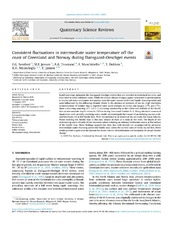| dc.contributor.author | Sessford, Evangeline | |
| dc.contributor.author | Jensen, Mari Fjalstad | |
| dc.contributor.author | Tisserand, Amandine Aline | |
| dc.contributor.author | Muschitiello, Francesco | |
| dc.contributor.author | Dokken, Trond Martin | |
| dc.contributor.author | Nisancioglu, Kerim Hestnes | |
| dc.contributor.author | Jansen, Eystein | |
| dc.date.accessioned | 2020-05-03T15:48:06Z | |
| dc.date.available | 2020-05-03T15:48:06Z | |
| dc.date.issued | 2019-11-01 | |
| dc.Published | Sessford E, Jensen MF, Tisserand AA, Muschitiello F, Dokken TM, Nisancioglu KH, Jansen E. Consistent fluctuations in intermediate water temperature off the coast of Greenland and Norway during Dansgaard-Oeschger events. Quaternary Science Reviews. 2019;223:105887:1-16 | eng |
| dc.identifier.issn | 0277-3791 | en_US |
| dc.identifier.issn | 1873-457X | en_US |
| dc.identifier.uri | https://hdl.handle.net/1956/22065 | |
| dc.description.abstract | Rapid warmings epitomize the Dansgaard-Oeschger events that are recorded in Greenland ice cores and imprinted in ocean sediment cores. While the abrupt climate changes appear connected to perturbations in sea ice and ocean circulation, it is unclear how the water masses within the Nordic Seas responded and were influenced by the inflowing Atlantic Water in the absence or presence of sea ice. High resolution reconstructions of benthic Mg/Ca, together with stable isotopes of carbon and oxygen (δ13C and δ18O), show a recurring warming (2.5° ± 0.5 °C) occurring consistently at the inflow and outflow of the Nordic Seas at intermediate depths down to 1500 m during Greenland Stadials 9–6. Using idealized numerical simulations with an eddy-resolving ocean model we investigate the impact of an isolating sea ice cover and freshwater lid in the Nordic Seas. With the presence of an extensive sea ice cover, the warm Atlantic Water entering the Nordic Seas in the east, retains its heat as it exits in the west. The depth of the recirculating warm Atlantic Water increases when including an external freshwater source at the surface of the Nordic Seas. These findings support the view that cold stadials are accompanied by pervasive intermediate water warming across the Nordic Seas. Given the current rates of Arctic sea ice loss, these results provide a potential mechanism for water-column destabilization and inception of abrupt climate change. | en_US |
| dc.language.iso | eng | eng |
| dc.publisher | Elsevier | en_US |
| dc.rights | Attribution CC BY-NC-ND | eng |
| dc.rights.uri | https://creativecommons.org/licenses/by-nc-nd/4.0/ | eng |
| dc.subject | Dansgaard-Oeschger cycles | eng |
| dc.subject | Quaternary | eng |
| dc.subject | Paleoceanography | eng |
| dc.subject | Climate dynamics | eng |
| dc.subject | Nordic seas | eng |
| dc.subject | North Atlantic | eng |
| dc.subject | Stable isotopes | eng |
| dc.subject | Micropaleontology | eng |
| dc.subject | Foraminifers | eng |
| dc.title | Consistent fluctuations in intermediate water temperature off the coast of Greenland and Norway during Dansgaard-Oeschger events | en_US |
| dc.type | Peer reviewed | |
| dc.type | Journal article | |
| dc.date.updated | 2020-02-10T08:37:42Z | |
| dc.description.version | publishedVersion | en_US |
| dc.rights.holder | Copyright 2019 The Authors | en_US |
| dc.identifier.doi | https://doi.org/10.1016/j.quascirev.2019.105887 | |
| dc.identifier.cristin | 1729933 | |
| dc.source.journal | Quaternary Science Reviews | |
| dc.relation.project | Notur/NorStore: NN4659K | |
| dc.relation.project | EC/FP7: 610055 | |
| dc.relation.project | Norges forskningsråd: 223272 | |

